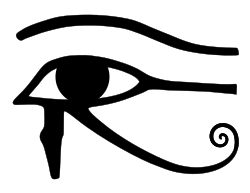Eye of horus
| Fractions in hieroglyphics | |||
|---|---|---|---|
Horus eye Udjat Wḏ3t intact, complete, whole, healthy |
|||
the white of the eye (left) = 1 / 2 hekat * |
|||
Pupil = 1 / 4 hekat |
|||
Eyebrow = 1 / 8 hekat |
|||
the white of the eye (right) = 1 / 16 hekat |
|||
1 line under the Horus eye = 1 / 32 hekat |
|||
2nd line under the Horus eye = 1 / 64th Heqat |
|||
the "ideal" eye Horus = 63 / 64 hekat |
|||
The Horus eye , also Udjat eye or Udzat eye is an ancient Egyptian symbol of the sky and light god Horus and an Egyptian hieroglyph with magical meaning. It has the number D10 in the Gardiner list .
In ancient Egypt
The conception of the eyes of Horus, which speaks of the sun and moon , must not be confused with the mythological areas of the eyes of Re and the eyes of Horus. The eye-legends published so far mostly mix up the topics that are independent of one another, which led to overall incorrect interpretations. There are a total of three topics:
- Eye of Re: Tefnut and Sopdet, among other things, as "Eye of Re".
- Horus eye (Udjat eye): Healing of the Horus eye and reference to the moon.
- Cosmic eyes of Horus : Shu as the sun and Tefnut as the moon. In a play on words , the name of the gods Schu is translated as light. The associated associations are less common and refer to the original amalgamation of the Tefnut with the Udjat eye.
In the "Udjat text genre", Seth tore out Horus' left eye when both rivals were fighting for the throne of Osiris . Thoth , the wise moon god, patron saint of science and writing, healed the eye.
Use in magic
The Horus eye is the left eye ("moon eye") of the light god Horus that was healed and restored by Thoth. It is also known as the Udjat or Udzat eye ( udjat = intact, complete, whole, healthy).
Originally the symbol served as a means of protection and was used as an amulet and protective symbol against the " evil eye " from the beginning of the Old Kingdom to the end of the Pharaonic era . In the New Kingdom , coffin walls and grave goods were decorated with it ("magic eyes").
Use in math
The Egyptologist Georg Möller claimed in 1911 that during his research he had discovered a pictorial notation for the first six binary fractions . These would be written as elements of the eye of Horus. The sum of the fractions is 63 ⁄ 64 . 1 / 64 has Thoth can supposedly disappear.
Eye of Horus with Heqat divisions
Analyzes by the Egyptologist Jim Ritter from 2002 indicate, however, that the ancient Egyptian mathematical fractions can be traced back to the hieratic script and that it cannot be assumed that the hieroglyphic symbols are generally used as units of measurement by the people.
Use in medicine
In creating a remedy, doctors used the mathematical relationship of the eye to dose the ingredients. The R-symbol for recipe that preceded it in medieval and early modern medical recipes was also similar to the eye of Horus. The Horus eye (as described above) was also used as an amulet, perhaps even as a healing spell.
In modern times
- The Horus eye is an essential component of the painting on the Maltese fishing boats Luzzu .
- The eye of Horus is also depicted on various tarot cards from Aleister Crowley's Thoth Tarot .
- The eye of Horus was from the progressive rock - band The Alan Parsons Project as a graphic for the cover of the 1982 studio album Eye in the Sky used.
- The Eye of Horus was used by the British rock band The Sisters of Mercy for the cover of the 1990 studio album Vision Thing .
See also
literature
- Hans Bonnet : Eye of Horus. In: Hans Bonnet: Lexicon of the Egyptian religious history. 3rd unchanged edition. Nikol, Hamburg 2000, ISBN 3-937872-08-6 , p. 314f.
- Alan Gardiner : Egyptian Grammar. Being an Introduction to the Study of Hieroglyphs. 3d revised edition. Griffith Institute - Ashmolean Museum, Oxford 1957. 1988 printing, ISBN 0-900416-35-1 (on the use of the eye of Horus for the formation of fractions: § 266) .
- Erhart Graefe : Middle Egyptian grammar for beginners. 4th completely revised edition. Harrassowitz, Wiesbaden 1994, ISBN 3-447-03445-9 .
- Alexandra von Lieven : Floor plan of the course of the stars. The so-called Nutbuch (= Carsten Niebuhr Institute Publications. Vol. 31; The Carlsberg Papyri. Vol. 8). The Carsten Niebuhr Institute of Ancient Eastern Studies u. a., Copenhagen 2007, ISBN 978-87-635-0406-5 .
Web links
Individual evidence
- ↑ Jim Ritter: Closing the Eye of Horus: The Rise and Fall of Horus-Eye Fractions. In: John M. Steele, Annette Imhausen (Ed.): Under One Sky: astronomy and mathematics in the ancient Near East (= Old Orient and Old Testament. [AOAT] No. 297). Ugarit-Verlag, Münster 2003, ISBN 3-934628-26-5 , pp. 298-323 ( full text online ).
- ↑ Liselotte Buchheim: History of the recipe introduction. Eye of Horus - Sign of Jupiter - Recipe . Medical habilitation thesis, Bonn 1965.




